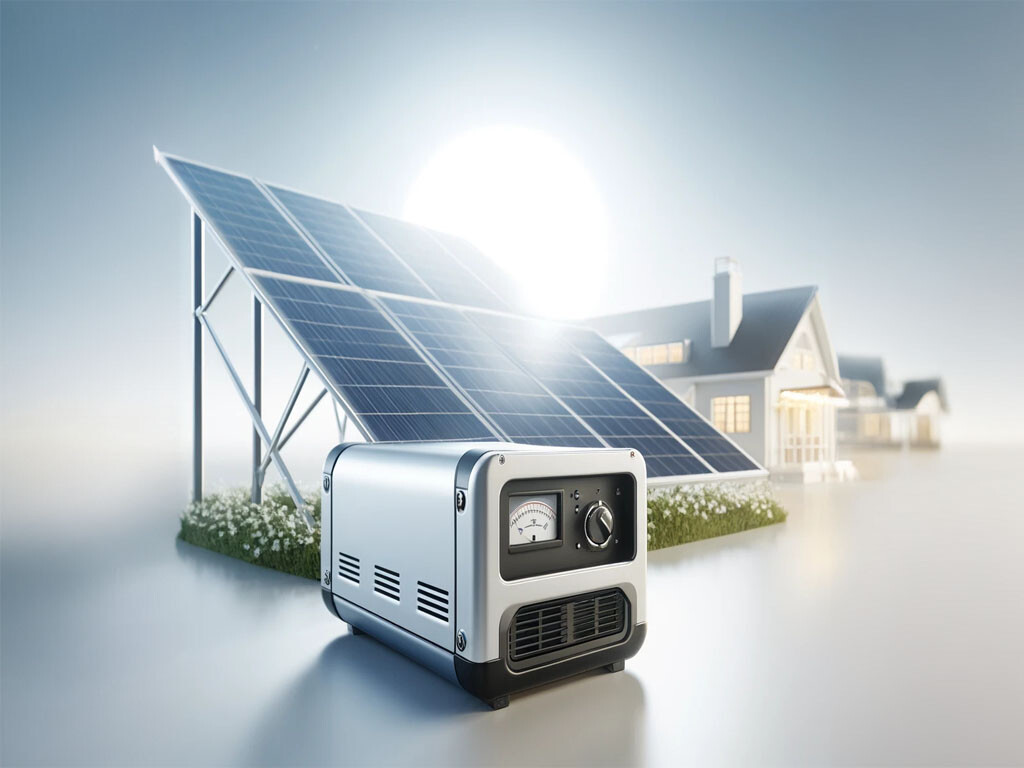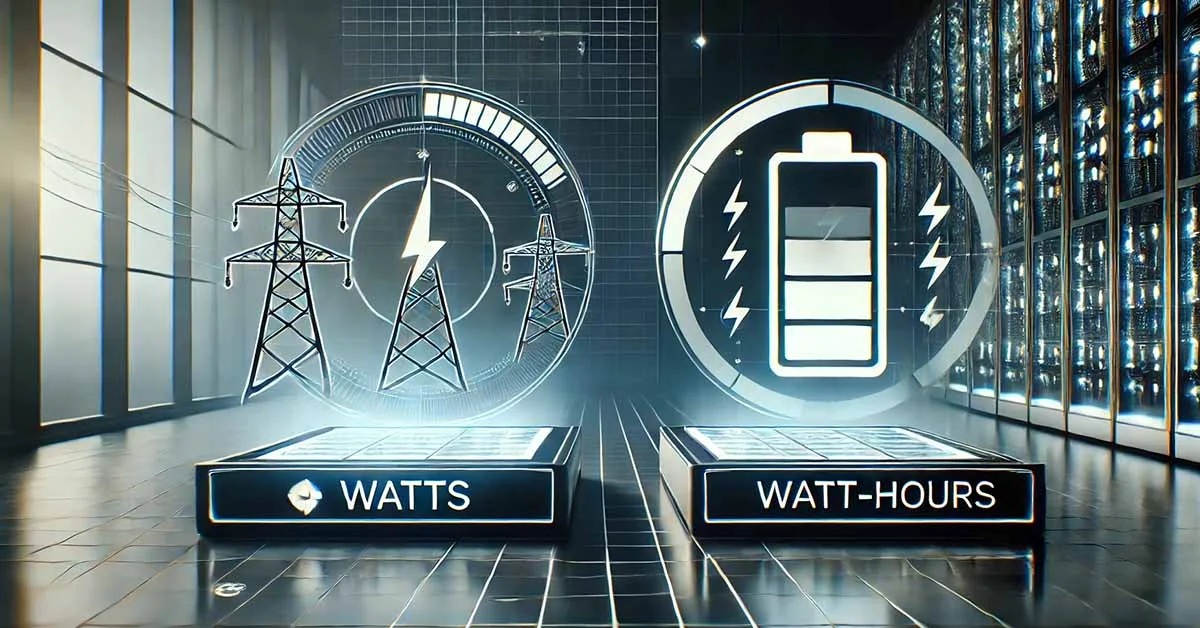When you’re looking around at different electrical devices, you may notice that quite a few specify their wattage or the watt-hours of the battery. While watts and watt-hours have a lot in common, these are two very different specifications and it’s worth understanding the difference.
This quick guide will lay out the watt and watt-hour difference in an easy-to-understand way. This can help you shop for portable power stations, calculate your electrical demand, and give you a much better understanding of many different electrical situations.
Let’s unravel this electrical mystery.
We carefully select the products and services we link to. If you buy through our links, we may earn a commission. There’s no extra cost to you and it helps us provide this information.

What Is a Watt?
A watt is a measure of power. The technical definition of watt is a unit of power equal to one joule per second. But outside in the real world, it’s better to think of a watt as how much power is moving at one moment.
Let’s imagine electricity is like water. If you want to move water from one place to another, it has to move to get there. This movement can be very fast or very slow. And this rate of movement is like the wattage of electricity. The higher the wattage, the faster the electricity can flow and the more energy it can provide.
Many electrical devices specify how many watts they use. For example, a small fan might have a rating of about 40W. While a large induction cooktop will use upwards of 2,000W or more.
For devices that provide power, like a portable power station, the wattage usually refers to the amount of power it can send out to other devices. As usual, the higher the wattage, the more power it can send out at one time. You can also use wattage to describe how much power you can generate.
The wattage of electronics will add up. So to power that 2,000W cooktop and the 40W fan, you need a power station that can send out 2,040W. If you also want to power a 500W refrigerator at the same time, you need 2,540W from the power station.

What Is a Watt-Hour?
It can be easy to overlook, but there’s one thing glaring from the discussion about wattage. We didn’t mention a single thing about how long the power lasts. That’s where the watt-hour comes into play.
The definition of watt-hour is a measure of energy equal to consuming one watt for one hour. In other words, watt-hour is about how long you provide a certain amount of energy for. It’s the actual amount of energy used. Or the energy that is stored in a battery.
So on one hand you have watts, which is how quickly the electricity flows. And on the other hand you have watt-hours, which is how much actual energy is used.
If we go back to the water analogy, watt-hours is like measuring how thirsty your devices are and how much water you must provide for them to run. The induction cooktop is very thirsty and will drink tons of water to run. You have to constantly provide it with a big stream of water. The small fan barely sips any water. At the end of a day, the induction cooktop can drain a large 50-gallon drum of water while the small fan only uses a cup. Watt-hours is the measurement of how much water (energy) these devices consume.
That’s watt-hours as a measurement of how much energy your devices use over time.
But watt-hours can also help us understand the size of batteries. A giant battery that powers an electric car is like a big swimming pool. You can pump out a firehose of energy for a long time. A tiny battery like that in your phone is like a little bucket. It’s enough power to light up the screen and run the processor, but that’s about it.

How Watts and Watt-Hours Work Together
The magic happens when you bring these two terms together. And we’ve basically already done so by going over what a watt-hour is.
- One watt-hour is running one watt for one hour.
- 50 watt-hours is running 50 watts for one hour.
This is straightforward. But there’s a lot more to the picture. Let’s now say you have a 10W fan and a 50Wh battery. You can run the fan for 5 hours. 50Wh / 10W = 5 hours.
This simple calculation is the key to understanding how much total energy your devices will use and how large of batteries you need to power them. It’s a crucial thing to know about watts and watt-hours, especially when shopping for things like a portable power station or home backup battery.
Let’s do a few more examples of how a watt and watt-hour are related and how they’re different:
- If a 200W television runs for one hour, it will use about 200Wh of energy. If that same 200W television runs for ten hours, it will use 2,000Wh of energy. Or 2kWh. Each hour adds up.
- If a 2,000W induction cooktop runs for one hour, it will use about 2,000Wh of energy. If that same cooktop only runs for half an hour, it will use about 1,000Wh of energy. You can use part of an hour.
There are many situations where a device might be rated for one wattage but doesn’t use that amount of power consistently. A refrigerator is an ideal example. Some can use up to 500W of power, but since the actual compressor starts and stops as needed to keep the fridge at the set temperature, it actually only uses 200W on average. So even though it’s rated at 500W, it only uses 200Wh per hour.

Specific Devices
You have the basic understanding of the difference between watt and watt-hours down. Now let’s see how it relates to a few of the specific devices that we focus on with many of our articles.
Portable Power Stations
Power stations have many specs, but the two most important are the inverter wattage and the battery watt-hours. These are two very different specs and they can be easily confused. A lot of the time, the model name includes a reference to the inverter or battery size, sometimes both.
The inverter rating in watts is usually in the same ballpark as the battery capacity in watt-hours.
The inverter wattage is the amount of power it can send out at one time from the AC outlets. The more powerful the inverter, the larger and more energy-hungry devices you can power. For example, a large power station can have a 3,000W inverter. It can power a 1,000W microwave and still have plenty of room leftover for other electronics. But a small power station has a 300W inverter and no matter how much battery power it has, it will never power a 1,000W microwave – not even for a second.
Note that wattage is also used to describe how much power can come out of other ports, like the USB ports. These do not use the AC inverter so they are rated separately and are usually much lower wattage.
The battery capacity is in watt-hours. And it’s how much power is stored inside. A large power station can have a 3,000Wh battery, which is enough to charge a small 10Wh phone battery about 300 times (a little less). A small power station might have a 300Wh battery and can charge the same phone only 30 times.

Solar Panels
Most solar panels are sold based on the expected watts they will produce. This is the maximum amount of energy that can flow off of them at one time.
For example, a 100W solar panel will generate up to 100W in ideal conditions. In the real world, you’re much more likely to see a lower maximum rate. It’s typically around 80% of the rated wattage, so a 100W panel might actually generate as much as 80W in full sunlight.
We can continue the same line of thought to turn this wattage into the watt-hours a panel can produce over time. Let’s say that you put a 100W panel in full sunlight for 4 hours. If we could get 100%, that would be equal to 400Wh of energy. We could either use that as it comes off the panels to power devices at 100W or less for the full 4 hours. Or we could send that power to a battery and recharge it with 400Wh of new sun-powered energy.

General Electronic Devices
There are many ways to identify how many watts your devices need to run and how many watt-hours they will use over a specific time. Here’s a quick rundown:
- Rated Wattage: If your device is rated in watts, that’s very easy to figure out. You know how many watts it uses and you just multiply by the number of hours to get the watt-hours it will use over that time.
- Rated Amps and Voltage: Some devices show you the current (amps) and voltage, but not the watts. You just multiply the amps by the voltage and that’s the wattage. Very simple. For example, many USB chargers are 5V at 3A. That is 15W. Use that charge for one hour straight and you’ll consume 15Wh of energy.
- Watt Meter: If you have a device that doesn’t run constantly – like a fridge – then you can use a device called a watt meter to record how much energy it actually uses in a given time. The watt meter is plugged in between the fridge and the power outlet. Let it run for a day then see how many watt-hours it uses. Divide by 24 to see the average wattage it runs at.
- Utility Bill: You can look up your monthly energy usage in kWh (kilo-watt-hours) on your energy bill. Divide that by 30 to get your daily kWh use.
With this knowledge, you can calculate how many watts almost any device uses and how many watt-hours you’ll need to power it for a set amount of time. To identify how big of a battery you need or how much something will cost you to power, you just consider the running wattage and the time you want to run. You can then figure out how much watt-hours nearly any set of devices will use.
Pro Tip: Always leave room for electrical loss and inefficiencies. We suggest planning on your devices needing about 20% more power than what the ratings might say. This accounts for energy lost to heat, inverter use, connections, long wires, and other real-world imperfections.

Ready to Power?
A watt is a measurement of how much energy is flowing at one time, while a watt-hour is how much power is consumed or stored over a set amount of time. One watt running for one hour is one watt-hour. 1W x 1h = 1Wh.
With this knowledge, you can calculate how much energy you will use with a specific set of devices. Or you can figure out what size battery you need for a power station.
Ready to continue your knowledge-building? Head over to our article on the Difference Between a Portable Power Station and an Inverter.







